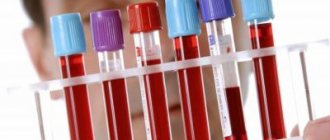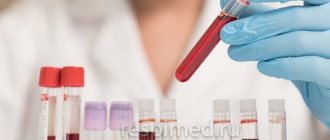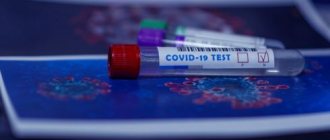What is C-reactive protein
Human blood contains a whole group of plasma proteins. One of them is C-reactive protein. This blood component is known for its hypersensitivity - it instantly reacts to the appearance of even the slightest inflammation in the body.
CRP is secreted by the liver. Its main function is to increase the body's immune defense.
Even with slight damage to internal tissues, CRP begins to rise, thereby forcing the entire system to work to increase the level of protection.
C-reactive protein “works” in tandem with pneumococcal polysaccharides. Combining together, they become a barrier to infection and prevent it from spreading throughout the body. These are some kind of protectors. It is no coincidence that the worse a person feels, the higher the level of this protein in the patient’s blood.
CRP actively stimulates the production of leukocytes and phagocytosis of cells. In other words, there is active stimulation of innate immunity.
Why donate blood
Among the possible biomaterials for research, blood for CMS comes first. A vein or finger can be collected. Most often it is prescribed to identify dysbiosis of the small intestine. But such research is no less in demand when it is necessary to identify or clarify the origin of the inflammatory or infectious process in all kinds of diseases.
Other biomaterials
Depending on what problem needs to be solved, it is possible not only to donate blood for CMS, but also to analyze other biomaterials:
- feces (to identify dysbiosis of the luminal microbiota of the colon);
- sputum, swabs from the throat, nasal and ear canals;
- urine;
- sperm and prostate secretions;
- vaginal discharge;
- biopsy samples and tissue exudates;
- washings from the skin.
Studies of microbiocenoses using the CMS method are used to assess reproductive status, in the treatment of infertility or other serious pathologies of the genital area in men and women.
What are normal echocardiography indicators in children?
In a study such as cardiac echocardiography, indicators allow you to see the condition of the vessels, valves, chambers and walls of the heart and evaluate their function. Using cardiac ultrasound, you can measure the size of the heart, atria and ventricles, the thickness of the heart walls, and evaluate the heart rhythm.
Cardiac ultrasound findings include the following:
- Left ventricular myocardial mass (LVMM).
- Left ventricular myocardial mass index (LVMI).
- Left atrium (LA) size.
- Thickness of the interatrial septum (AS).
- Right ventricle (RV) size.
- End diastolic (EDV) and end systolic volume (ESV) of the left ventricle.
- Thickness of the posterior wall of the left ventricle (PLW).
- Thickness of the free wall of the right ventricle.
- Pancreas size index.
- The thickness of the interventricular septum (IVS) in systole and diastole.
- Ejection fraction (EF).
- Stroke volume (SV).
- Blood flow velocity in the pulmonary artery.
With cardiac ultrasound, normal indicators depend on the person’s age and differ in children and adults.
The norms for cardiac ultrasound in adults are somewhat different for men and women. The table below shows the normal cardiac ultrasound for both sexes.
Table 1. Normal indicators of cardiac echocardiography for adults
| Heart ultrasound indicator | Norm for men | Norm for women |
| LVM | 135-182 g | 95-141 g |
| LVMI | 71-94 g/m2 | 71-84 g/m2 |
| EDV of the left ventricle | 65-193 ml | 59-136 ml |
| Left ventricular ESR | 50-60 ml | 50-60 ml |
| Left ventricular EDR | 4.6-5.7 cm | 4.6-5.7 cm |
| Left ventricular ESR | 3.1-4.3 cm | 3.1-4.3 cm |
| LV thickness | 1.1 cm | 1.1 cm |
| MZhP thickness | 9-10 mm | 9-10 mm |
| TZSLZH | 9-11 mm | 9-11 mm |
| FV | 55-60% | 55-60% |
| Pancreas size index | 0.75-1.25 cm/m2 | 0.75-1.25 cm/m2 |
| Pancreas wall thickness | {amp}lt;0.5 cm | {amp}lt;0.5 cm |
| Pancreas diameter | 7-26 mm | 7-26 mm |
| UO | 60-100 ml | 60-100 ml |
| LA size | 1.85-3.3 cm | 1.85-3.3 cm |
| LA size index | 1.45-2.9 cm/m2 | 1.45-2.9 cm/m2 |
| Aortic root | 20-38 mm | 20-38 mm |
| Pulmonary aortic orifice | 11-22 mm | 11-22 mm |
| Permissible amount of fluid in the pericardium | 10-30 ml | 10-30 ml |
When performing cardiac ultrasound, normal values in children differ depending on age. Below in the table we present the norms of EchoCG in older children and infants.
Table 2. Normal echocardiographic findings for children
| EchoCG parameter | Normal echocardiography in girls | Normal echocardiography in boys |
| LP and MPP in diameter | 11-16 mm | 12-17 mm |
| Pancreas diameter | 5-23 mm | 6-14 mm |
| LV EDC | 16-21 mm | 17-22 mm |
| LV ESR | 11-15 mm | 11-15 mm |
| TZSLZH | 2-4 mm | 3-4 mm |
| Free wall of the pancreas | 0.2-0.3 cm | 0.2-0.3 cm |
| FV | 65-75% | 65-75% |
| Pulmonary artery blood flow velocity | 1.42-1.6 m/s | 1.42-1.6 m/s |
Table 3. EchoCG norms in infants
| EchoCG parameter | Norm for girls | Norm for boys |
| LV EDC | 18-24 mm | 19-25 mm |
| LV ESR | 12-17 mm | 12-17 mm |
| LP in diameter | 12-17 mm | 13-18 mm |
| LV diameter | 5-13 mm | 6-14 mm |
| TZSLZH | 3-5 mm | 3-5 mm |
| MZhP thickness | 3-6 mm | 3-6 mm |
| Pancreas thickness | 2-3 mm | 2-3 mm |
| Pulmonary artery blood flow velocity | Approximately 1.3 m/s | Approximately 1.3 m/s |
Echocardiography standards, as we see, allow us to evaluate a number of indicators, thanks to which we can judge the presence of structural and functional changes in the heart and blood vessels. With echocardiography, the norm of indicators differs depending on age and gender, so the examination and interpretation should only be carried out by an experienced sonologist!
Deviations from the norm EchoCG may indicate various disorders and diseases, namely:
- Pericarditis, myocarditis, endocarditis.
- Cardiac ischemia.
- Cardiomegaly.
- Cardiomyopathy.
- Heart failure.
- Presence of heart defects and valve defects.
- Pulmonary hypertension.
- Atherosclerosis.
- Vascular stenosis.
- Presence of blood clots, aneurysms, heart tumors.
- Rheumatic heart disease.
Therefore, during an examination such as echocardiography, norms are of the greatest importance - knowing them allows you to correctly decipher the results and make an accurate diagnosis!
Why get tested?
Biochemistry to detect the level of CRP in the blood is prescribed to detect foci of inflammation. When present, the level of this protein increases several times.
This study helps determine the nature of the inflammation: viral or bacterial.
Biomaterial collection is mandatory after surgery. In this way, the attending physician monitors the quality of rehabilitation. Nature intended that immediately after surgery, the level of protein “takes off” sharply in order to maximally protect the body from infection. As soon as the patient begins to return to normal, the level of CRP immediately stabilizes.
Thus, the main objectives of the study are:
- Determine the degree of intensity of the inflammatory process
- Monitor whether drug therapy is successful
- Monitoring postoperative complications
- Determine whether the body has begun to reject tissue after transplantation
Today, such diagnostics are carried out using two methods:
- Veltman's test
- alpha - 1 - antitrypsin
When is a blood test for CSR prescribed?
Purpose of analysis
There are several indications when it is necessary to donate blood to determine the presence or absence of syphilis in the human body.
Such indications include:
- Promiscuous sexual intercourse (both casual and not). People do not always protect themselves during sexual intercourse, and therefore the risk of contracting syphilis increases several times.
- Preparation before surgery, when it is very important for doctors to know about the general condition of the human body and whether they need to take any extra safety measures to avoid becoming infected themselves.
- Pregnancy, during which it is very important to conduct a complete diagnosis of the expectant mother’s body and understand how great the chances are of bearing the baby. And besides, syphilis poses a danger to the child, and therefore, in some cases, this may prompt termination of pregnancy.
- Pregnancy planning. This process is designed to ensure that future parents consciously undergo examination in order to approach the issue of conception seriously. During this event, all possible diseases are identified, as well as existing infections that need to be treated immediately.
- Ulcers on the genitals, which may indicate the presence of a serious and dangerous disease.
- Copious discharge from the genitals of various types.
- Enlarged lymph nodes, mainly in the groin area.
- A rash on the body that may be accompanied by severe itching.
- Painful sensations in the bone area.
Also, blood testing for syphilis (DBS) is given at every preventive examination for one purpose, in order to detect the problem in time.
Blood for CSR analysis transcript
Diagnosis of syphilis is based on clinical and laboratory data. The diagnosis of syphilis is made only after laboratory confirmation, i.e., detection of pale treponema in the discharge of chancre, erosive, papules in primary and secondary syphilis, and serological examination data. Serological reactions are an extremely valuable method not only for confirming the diagnosis of syphilis, but also for monitoring the dynamics of its course under the influence of treatment and determining whether the disease is cured.
RIT, RIBT - Treponema pallidum immobilization reaction
Treponema pallidum immobilization test (TPI) is a classic method used to detect specific treponemal antibodies. The RIBT reaction uses pathogenic Treponema pallidum T. pallidum (Nichols strain) grown in a rabbit testicle as an antigen.
RIBT is based on the loss of motility of living Treponema pallidum after exposure to antibodies from the patient's blood serum and complement. The results are assessed using dark-field microscopy. Although the RIBT test was introduced into clinical practice as a specific test for syphilis, it is labor-intensive, technically complex, time-consuming and expensive to use.
Indications for analysis
Laboratory blood diagnostics for elevated c-reactive protein are prescribed in the following cases:
- postoperative period;
- condition after a stroke;
- diabetes;
- hypertension;
- cardiac ischemia;
- the appearance of tumors, both benign and malignant;
- latent infections.
- examination before surgery, especially before coronary artery bypass grafting.
Doctors recommend that everyone undergo this examination at least once a year. Men and women aged 60+ are at risk. It is better to prevent a disease than to try to treat it for a long time.
Preparing for the examination
The effectiveness of the analysis directly depends on how correctly the biomaterial is submitted. To avoid misinterpretations and subsequent false diagnoses, it is recommended to follow a number of tips for preparing for blood donation:
- avoid fatty and spicy foods;
- eliminate alcohol;
- avoid overheating or hypothermia;
- do not be nervous;
- try to maintain a 12-hour fasting break before taking the test;
- Blood biochemistry: how to prepare for analysis
What does a biochemical blood test for CRP indicate?
When the results of a biochemical blood test to determine the level of CRP are on your hands, it is important not to start panicking ahead of time, but to try to understand what these mysterious numbers mean. The result will be ready the next day after the biomaterial is submitted.
Each laboratory has its own reagents, so the reference values may fluctuate somewhat. If we take the average indicator, then it is considered that the normal level of c-reactive protein is considered to be from 0 to 0.3-0.5 mg/l. These digital guidelines were introduced relatively recently. Previously, the transcript could be seen either “positively,” which was considered the norm, or “negatively.” In the latter case, the number of crosses from 1 to 4 was displayed next to the result. The more pluses, the stronger the inflammation.
The norm in women may vary depending on the following factors:
- pregnancy;
- use of hormonal contraceptives;
- age over 50.
So for an expectant mother, normal levels are up to 3.0 mg/l. This is due to hormonal changes.
A woman over fifty should have no C-reactive protein.
In men, the protein level should not exceed 0.49 mg/l.
It is very important to monitor CRP levels in children. Normally, fluctuations can be from 0 to 10 mg/l. Any increase in this indicator is a reason to begin serious treatment. The first analysis is taken in the first hours of the baby’s life from the umbilical cord. Necessary to rule out neonatal sepsis.
An increase in c-reactive protein in children can be a symptom of meningitis, influenza, rubella and other “childhood” diseases.
Preparing and interpreting a blood test
How to properly prepare for donating blood for a DBS test
It is very important to follow all the doctors’ recommendations in preparing for the test. The reliability of the results obtained sometimes depends on this.
A patient who has received a referral for a CSR test must refrain from eating food at least 8 (and preferably 12) hours before the procedure itself, as this can sometimes lead to either a false-positive or false-negative test.
If a person cannot avoid eating for such a long period of time (for example, diabetics or pregnant women), then it is necessary to exclude tea, coffee, and any juices. You are allowed to drink only plain water (boiled or filtered).
At the moment when scientists received such a method for diagnosing syphilis, it became possible to detect it even with a latent course.
The Wasserman reaction is of particular importance for any venereologist because:
- It allows you to determine even the moment of infection, of course, not with an accuracy of days, but the approximate interval and duration of the disease is quite good.
- It is possible to determine the presence of syphilis even if it occurs in a latent form.
- This is the only normal indicator of how effectively the treatment is proceeding and whether there are positive dynamics.
More information about the analysis can be found in the video.
Read: Norm and interpretation of general and biochemical blood tests in men
Also, the doctor is guided by the results of the analysis when carrying out preventive measures at the source of infection, which is also important. Patients are accustomed to the fact that the test result can be either positive or negative. But with syphilis the situation is a little different.
A negative result can occur either in the complete absence of infection or in early primary or late tertiary syphilis.
As for a positive result, it indicates that the infection is present in the body (depending on the accuracy of the indicators), or that the person is at the stage of recovery or in the first year after treatment. That is, when receiving the result of the analysis, it is impossible to say with certainty whether a person is healthy or not. Especially when it comes to patients undergoing treatment.
In the event that a person was not tormented by symptoms and did not undergo any treatment, and his analysis was negative, then this indicates a complete absence of the disease.
Wasserman reaction
A set of serological reactions (CSR), one of which is known as the Wassermann reaction, is a valuable diagnostic method. It allows both to identify the infection and determine the stage of the disease. A blood test for syphilis KSR must be supplemented with treponemal-specific methods of analysis (RIBD and ELISA). To carry out the CSR test, antigens extracted from the heart muscle of cattle are used, which are similar in their properties to Treponema pallidum antigens.
The CSR is not a specific test for syphilis: a positive CSR is possible in patients with tuberculosis, malaria, autoimmune diseases, oncology, during pregnancy and other conditions. It is mandatory to take a test for syphilis during pregnancy, since the presence of this disease in a pregnant woman can lead to a miscarriage or the birth of a child with a congenital disease.
The express method is an accelerated version of the Wasserman reaction. When performing a rapid test for syphilis, a cardiolipid antigen is also used, which is mixed with serum in the recess of a special glass plate.
How long it takes to complete a test often depends on the technique used. Typically, the express method takes about half an hour.
The reaction result of the express method is evaluated in the same way as the DFR, with positive numbers from 0 to +4. The sensitivity of the express method, although superior to the CSR, may give a false positive result due to another disease.
ORS and UMSS are another variant of the Wasserman reaction or express method. The abbreviation UMSS stands for the accelerated method for latent syphilis. ORS stands for selection reaction to syphilis. When performing ORS, the same reagents are used as in the Wasserman reaction.
Complex of classical serological reactions (CSR)
When conducting diagnostic tests for syphilis, various
serological tests
: agglutination, precipitation, immunofluorescence, complement fixation, enzyme immunoassay, etc. All these serological reactions are based on interaction
antigens and antibodies
.
Specific serological tests are called treponemal tests because these tests use Treponema pallidum or their antigens, that is, antigens of treponemal origin. The purpose of treponemal tests is to identify specific antibodies to the antigenic structures of the causative agent of syphilis, that is, antibodies directed specifically against the T bacteria themselves.
As in
non-treponemal tests
, when conducting treponemal tests, the “antigen-antibody” reaction is used. To perform and detect the results of the antigen-antibody reaction, more complex and expensive methods are used than in the case of non-treponemal tests.
Timely and high-quality recognition of syphilitic infection is currently associated with the widespread introduction of treponemal tests.
Treponemal tests are used to confirm the presence of syphilis - they are used to check the results of non-treponemal tests, which is especially necessary for diagnosis
latent forms of syphilis
. Treponemal tests are also used to detect syphilis in the early stages when non-treponemal
cardiolipin tests
(Wasserman reaction, microprecipitation reaction, etc.) negative.
Treponemal tests are used only for diagnosing syphilis and are not used to monitor cure rates, because treponemal reactions in some patients may remain positive for many years after complete treatment of syphilis.
However, when conducting treponemal tests, a small number of studies may encounter
false positives
, especially if the patient has diseases such as infectious mononucleosis, connective tissue diseases, leprosy or injection drug addiction.
In clinical specificity, treponemal tests are comparable to non-treponemal tests, and in clinical sensitivity they are superior.
To date, more than 20 variants of treponemal specific serological tests have been proposed. When they are carried out, whole cells or individual cells are used as an antigen.
T. pallidum antigens
strain Nichols from a rabbit testicle, cultured treponema or recombinant Treponema pallidum proteins.
When performing treponemal tests, various types of antigens are used
- live or fixed treponemes;
- purified and sonicated treponemes (sonicate). Cultured or (rarely) pathogenic strains of T. pallidum are used;
- T. pallidum-specific biosynthetic or recombinant antigens.
- An antigen of treponemal origin is used: either prepared treponemes or recombinant proteins are used - antigens of the pathogen;
- Tests detect treponeme-specific antibodies
- Methods – diagnostic, confirmatory, “gold standard”
- High sensitivity: the sensitivity of treponemal tests ranges from 70 to 100% depending on the type of test and the stage of syphilis;
- High specificity: the specificity of treponemal tests is 94 – 100%;
- False-positive reactions are less common with treponemal tests than with non-treponemal tests;
- “Reliability” in diagnosing late forms of syphilis
- Conducting population screening (ELISA, RPGA, simple quick tests are used). Screening of certain categories of the population for syphilis (donors, pregnant women, patients in ophthalmological, psychoneurological, cardiological hospitals, HIV-infected).
- Confirmation of positive non-treponemal test results
- Tests are used to exclude false positive results (FPR), retrospective confirmation of diagnosis
- Confirmation in case of discrepancy between the results of a screening treponemal test and a subsequent non-treponemal test, as well as screening and confirmatory treponemal tests;
- treponemal tests cannot be used to monitor the effectiveness of therapy, since antitreponemal antibodies circulate for a long time in the body of a patient who has had a syphilitic infection;
- give positive results for non-venereal treponematoses and spirochetosis (borreliosis, pinta, yaws, bejel);
- may give false-positive reactions in patients with autoimmune diseases, leprosy, oncopathology, endocrine pathology and some other diseases.
- Treponemal tests are more expensive to perform per patient than non-treponemal tests, so the costs of screening for syphilis increase
- Complement fixation reaction (Wassermann reaction) with treponemal antigen (RSKt).
- Immunofluorescence reaction (RIF; Fluorescent treponemal antibody, FTA). It is used in several modifications: RIF-200 (FTA-200); RIF-abs (FTA-abs; FTA-abs double staining; FTA-abs IgM; RIF-abs-IgM; 19S-IgM-FTA-abs); RIFc - immunofluorescence reaction with whole blood.
- Passive hemagglutination test (RPHA; Treponema pallidum haemagglutination assay, TPHA).
- Passive agglutination reaction of gelatin particles sensitized with antigens of the causative agent of syphilis (TPPA, Treponema pallidum particle agglutination assay)
- Enzyme-linked immunosorbent assay (ELISA; Enzyme Lynced Immunosorbent Assay, ELISA).
- ICL - chemiluminescence immunoassays (CLIA)
- Immobilization reaction of Treponema pallidum RIBT (RIBT), in foreign literature TPI (Treponema pallidum immobilization test). In recent years, it has been used less and less and only for scientific purposes and in research laboratories.
- Immunoblotting (IB; Western Blot, Line Blot). As a rule, the method of linear immunoblotting, which is a variant of enzyme immunoassay, is used. Used in two versions: to detect IgG and IgM antibodies to the causative agent of syphilis
The passive hemagglutination test (RPHA) and enzyme-linked immunosorbent assay (ELISA) for antibodies of the IgM, IgG and total classes have universal significance and are used both for screening and for confirming the diagnosis. These methods are simple and accessible, highly reproducible, and automated. When using ELISA or RPGA, a prerequisite is the use of the same test system in the re-analysis as in the initial examination.
RIF (fluorescent treponemal antibody, FTA) is based on fluorescent microscopy visualization of antigen-antibody complexes using fluorochrome-labeled anti-human Ig serum.
The RIF, ELISA, and immunoblotting (IB) methods make it possible to detect specific antibodies to T. pallidum antigens (with syphilis, test results become positive) from the 3rd week from the moment of infection and earlier, RPGA and RIBT - from the 7–8th week.
Of the most common specific treponemal tests in world practice, which use the agglutination reaction, the following can be listed. In RPHA (Treponema pallidum hemagglutination assay, TPHA), microhemagglutination reaction (microhemagglutination assay for Treponema pallidum, MHA-TP), with a positive result, agglutination of red blood cells sensitized (treated) with treponemal antigen occurs in the presence of antitreponemal antibodies.
The use of latex or gelatin particles as a carrier in the TPPA test (Treponema pallidum particle agglutination) allows the use of a stress test in the case of erythrocyte lysis (decomposition of erythrocytes due to destruction of their membrane) by the sera of some patients, and also imparts stability to the reagents.
Treponemal tests
| Antigen | Catching system | Test |
| Live pathogenic treponema | Suspension of live Treponema | RIT, RIBT (treponema pallidum immobilization reaction) |
| Intact Treponemas | Treponemas fixed on glasses | RIF (immunofluorescence reaction), RIF-abs (RIF with absorption), RIF-c, RIF with capillary blood from a finger, etc. |
| Treponemas purified and destroyed by ultrasound | Associated with red blood cells | RPHA (passive hemagglutination reaction) |
| Associated with gelatin particles | Particle agglutination test (TPPA) | |
| Bound to the surface of the microplate wells | ELISA | |
| Proteins separated by polyacrylamide gel electrophoresis and transferred to membranes by Western blotting | Immunoblotting | |
| Recombinant | Bound to the surface of the microplate wells | Recombinant ELISA |
| Proteins separated by polyacrylamide gel electrophoresis and transferred to membranes by Western blotting | Immunoblotting with recombinant Ags | |
| Associated with latex particles | Latex agglutination |
CSR is a set of reactions used for the serodiagnosis of syphilis as a standard method. This complex of reactions includes the Wassermann reaction with cardiolipin antigen (an extract from the bovine heart enriched with lecithin and cholesterol) and treponemal antigen (an ultrasound-treated suspension of apathogenic cultured treponemes pallidum), as well as a microprecipitation reaction (MPR) with plasma or inactivated serum, which is put with cardiolipin antigen
The CSRs become positive in the middle of the primary period (its division into seronegative and seropositive is precisely determined by the CSR), in the secondary period the CSRs are positive in 98-100% of patients, and in the tertiary period - only in 60-70%. That is, as the duration of the disease increases, the positivity of the CSR gradually decreases.
Reasons for deviations from the norm
Most often, proteins are elevated in the test results. This is justified by the following reasons:
| Pathological deviations | Physiological reasons |
|
|
It is important to know that as C-reactive protein increases, the content of sialic acid increases. Its level should vary within 730 mg/liter. If both indicators are significantly higher than normal, then we can talk about serious inflammation, even tissue death.
Of course, increased plasma reactive protein levels are just a symptom. The diagnosis will be made by a doctor based on research. Sometimes additional diagnostics are required. Follow all the recommendations, and then the chance of avoiding the unpleasant consequences of an advanced disease will be maximum.
Tumormaker NSE - norm and interpretation of results
The level of neurospecific enolase is determined in venous blood. The normal level of the NSE tumor marker is up to 16.3 ng/ml. If the level of the substance is within normal limits, this can be regarded as the absence of cancer. However, we must remember that in the initial stages of cancer the tumor marker may not increase.
The reasons for an increase in NSE are the following conditions:
- Small cell form of lung cancer;
- Neuroblastoma, medulloblastoma;
- Thyroid cancer;
- Pheochromocytoma;
- Neuroendocrine tumor of the pancreas;
- Seminoma;
- Brain damage (stroke, head injury);
- Non-oncological lung diseases (for example, benign neoplasms, tuberculosis).
Accept that if the NSE tumor marker is slightly elevated, this most likely speaks in favor of a non-malignant process. While a significant increase in tumor markers in the presence of alarming symptoms may well indicate an oncological process. One way or another, the doctor deciphers the analysis, and the results of other studies are necessarily taken into account.
Valeria Grigorova, doctor, medical columnist
4, total, today
(51 votes, average: 4.78 out of 5)
Related Posts
Fluorescein angiography of the retina: indications, procedure, study results








